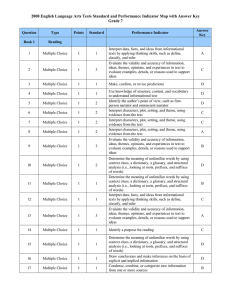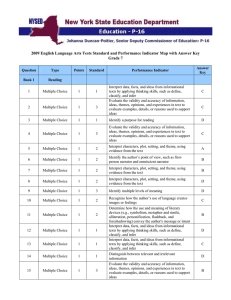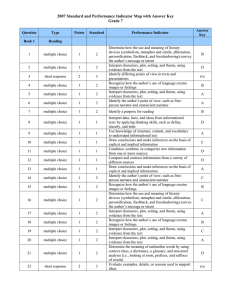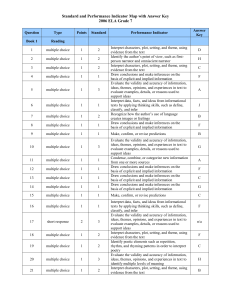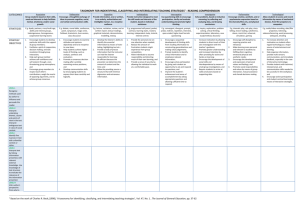2010 English Language Arts Tests Standard and Performance Indicator Map... Grade 7
advertisement
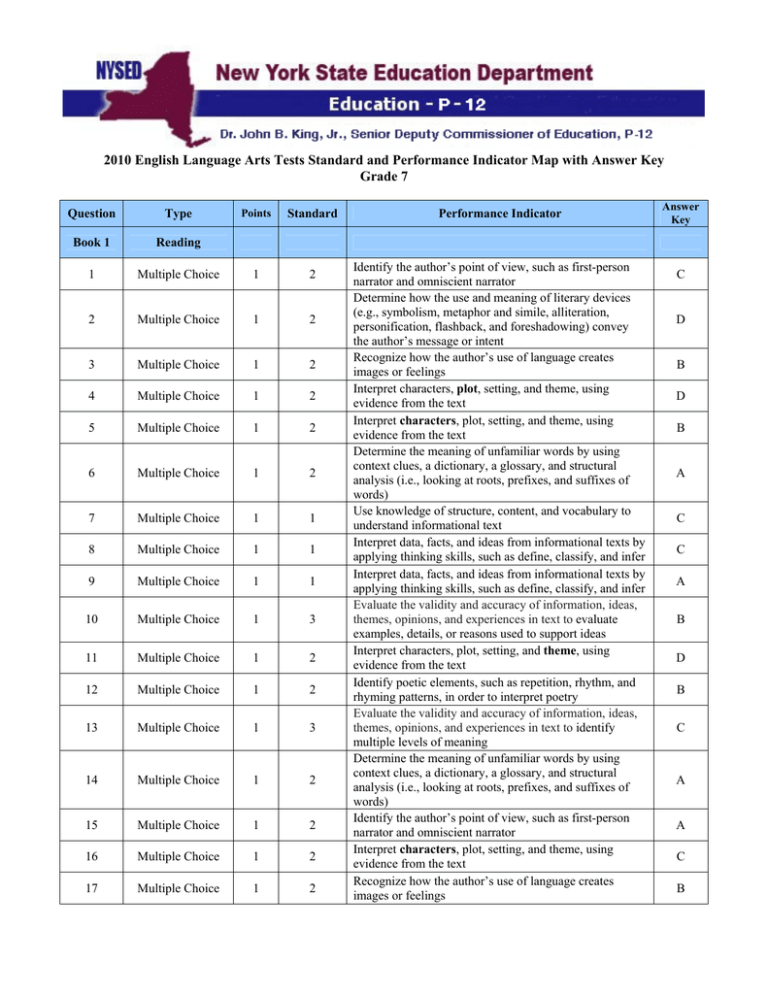
2010 English Language Arts Tests Standard and Performance Indicator Map with Answer Key Grade 7 Question Type Points Standard Book 1 Reading 1 Multiple Choice 1 2 2 Multiple Choice 1 2 3 Multiple Choice 1 2 4 Multiple Choice 1 2 5 Multiple Choice 1 2 6 Multiple Choice 1 2 7 Multiple Choice 1 1 8 Multiple Choice 1 1 9 Multiple Choice 1 1 10 Multiple Choice 1 3 11 Multiple Choice 1 2 12 Multiple Choice 1 2 13 Multiple Choice 1 3 14 Multiple Choice 1 2 15 Multiple Choice 1 2 16 Multiple Choice 1 2 17 Multiple Choice 1 2 Performance Indicator Identify the author’s point of view, such as first-person narrator and omniscient narrator Determine how the use and meaning of literary devices (e.g., symbolism, metaphor and simile, alliteration, personification, flashback, and foreshadowing) convey the author’s message or intent Recognize how the author’s use of language creates images or feelings Interpret characters, plot, setting, and theme, using evidence from the text Interpret characters, plot, setting, and theme, using evidence from the text Determine the meaning of unfamiliar words by using context clues, a dictionary, a glossary, and structural analysis (i.e., looking at roots, prefixes, and suffixes of words) Use knowledge of structure, content, and vocabulary to understand informational text Interpret data, facts, and ideas from informational texts by applying thinking skills, such as define, classify, and infer Interpret data, facts, and ideas from informational texts by applying thinking skills, such as define, classify, and infer Evaluate the validity and accuracy of information, ideas, themes, opinions, and experiences in text to evaluate examples, details, or reasons used to support ideas Interpret characters, plot, setting, and theme, using evidence from the text Identify poetic elements, such as repetition, rhythm, and rhyming patterns, in order to interpret poetry Evaluate the validity and accuracy of information, ideas, themes, opinions, and experiences in text to identify multiple levels of meaning Determine the meaning of unfamiliar words by using context clues, a dictionary, a glossary, and structural analysis (i.e., looking at roots, prefixes, and suffixes of words) Identify the author’s point of view, such as first-person narrator and omniscient narrator Interpret characters, plot, setting, and theme, using evidence from the text Recognize how the author’s use of language creates images or feelings Answer Key C D B D B A C C A B D B C A A C B 2010 English Language Arts Tests Standard and Performance Indicator Map with Answer Key Grade 7 (continued) Question Type Points Standard Book 1 Reading 18 Multiple Choice 1 2 19 Multiple Choice 1 3 20 Multiple Choice 1 1 21 Multiple Choice 1 1 22 Multiple Choice 1 1 23 Multiple Choice 1 3 24 Multiple Choice 1 1 25 Multiple Choice 1 3 26 Multiple Choice 1 1 27 Short Response 2 1 28 Short Response 2 3 Book 2 Listening and Writing 29 Multiple Choice 1 1 30 Multiple Choice 1 1 31 Multiple Choice 1 1 32 Multiple Choice 1 1 33 Short Response 2 1 34 Short Response 2 3 35 Editing Paragraph 3 n/a Performance Indicator Interpret characters, plot, setting, and theme, using evidence from the text Evaluate the validity and accuracy of information, ideas, themes, opinions, and experiences in text to identify multiple levels of meaning Interpret data, facts, and ideas from informational texts by applying thinking skills, such as define, classify, and infer Draw conclusions and make inferences on the basis of explicit and implied information Draw conclusions and make inferences on the basis of explicit and implied information Evaluate the validity and accuracy of information, ideas, themes, opinions, and experiences in text to consider the background and qualifications of the writer Use knowledge of structure, content, and vocabulary to understand informational text Evaluate the validity and accuracy of information, ideas, themes, opinions, and experiences in text to evaluate examples, details, or reasons used to support ideas Determine the meaning of unfamiliar words by using context clues, a dictionary, a glossary, and structural analysis (i.e., looking at roots, prefixes, and suffixes of words) Interpret data, facts, and ideas from informational texts by applying thinking skills, such as define, classify, and infer Evaluate the validity and accuracy of information, ideas, themes, opinions, and experiences in text to identify cultural and ethnic values and their impact on content Draw conclusions and make inferences on the basis of explicit information Draw conclusions and make inferences on the basis of explicit information Draw conclusions and make inferences on the basis of explicit information Recall significant ideas and details, and describe the relationships between and among them Support ideas with examples, definitions, analogies, and direct references to the text Present clear analysis, using examples, details, and reasons from text Observe rules of punctuation, italicization, capitalization, and spelling Use correct grammatical construction Answer Key B B A B C C B B A n/a n/a A A C B n/a n/a n/a
